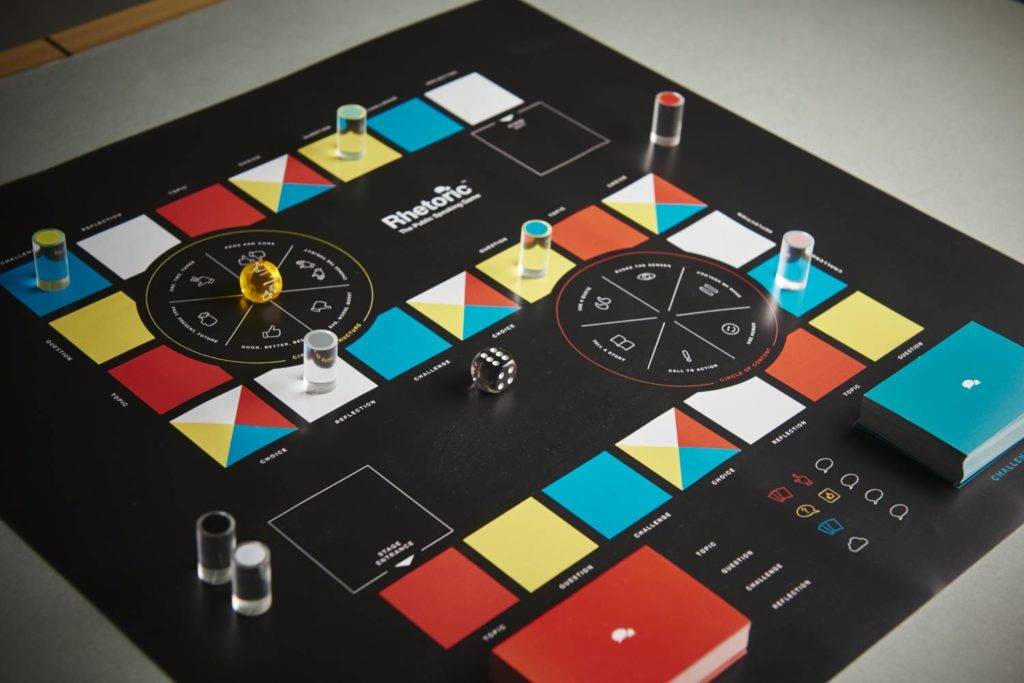
Gamification is serious business. I have written before about Rhetoric – The Public Speaking Game™, the board game and app that Florian Mueck and I co-created. You can read recent posts here and here.
Recently, I was interviewed about the game on Dukascopy Swiss Financial TV. My interview with Jack Everitt below.
While discussing the RHETORIC, I mentioned how the game can help people with their nerves when they have to speak in public.
By bringing gamification public speaking, we have combined elements of fun, competition, play and socialization to create an environment that is conducive to enjoyment and learning. But there is something else that I have noticed.
In the real world, many people (understandably) get nervous when they have a presentation to give. They prepare, the nerves build, the big day comes and they give their presentation. And usually, it goes fine. But then what happens?
For many people, they go back to their regular tasks and they do not have to speak again in public for weeks or months or possibly a whole year. And when that next speaking engagement comes around, the process of getting nervous begins all over again because so much time has elapsed between presentations.
With Rhetoric – The Public Speaking Game™, you must give a short (1- or 2-minute) speech every turn. You don’t have that much time between turns. For example, if you play with five other people, you will probably only have 10 to 15 minutes between your speeches. There isn’t a lot of time to get nervous before it is your turn again.
So here’s what happens.
A player—let’s call him Tim—is nervous about playing RHETORIC. For his first turn, he rolls the dice, finds out what his speaking assignment is, and then speaks for a minute or so. The other players applaud and the turn passes to the next player. Meanwhile, Tim sits back, somewhat relieved but also pleased with the fact that he has spoken and the world did not end.
Pretty soon, it is Tim’s turn again. Now he and all the other players have spoken once. Everyone is in the same boat. Tim is still a bit nervous, but less so. He rolls the dice, gets his next speaking assignment and once again speaks. The second speech might be better than the first one or it might be worse. It doesn’t matter. Once again, the other players applaud and encourage Tim, just as Tim has applauded and encouraged the other players. And the world has still not come to and end.
By his third turn, Tim starts to think that this is fun. It doesn’t matter whether he gives a good speech or a bad speech, the fun comes from just getting up there and speaking. Everyone is having a good time. And so what is often a vicious circle in the real world becomes a virtuous circle in the game.
Florian and I have seen real transformation in people throughout the course of a single game. Players who were nervous at the start are champing at the bit and eagerly jumping on stage by the end. And therein lies power of RHETORIC.
If you would like to learn more about the game, you can click on either of the links at the top of this post or visit our website.
If gamification is not your thing, find ways to reduce the amount of time between your public speaking engagements. As is the case with learning any skill, the more you do it, the easier it becomes.
















4 Replies to “Gamification can help overcome public speaking nerves”
Thanks, Alexandra. Much appreciated. Indeed, it is easy to get rusty quickly when it comes to public speaking. That’s why I tell clients to seize every opportunity to speak, even if it is just to rise at lunch and proposed a 30-second toast. That’s 30 seconds more of experience.
True for myself and for my clients…the amount of time between speaking gigs makes a difference. Love the concept of the game! Thanks for sharing.
My name is Presley Passion and I love what you do I also offer online training in how to become a better public speaker, search for the bold Muvement on WordPress inorder to find more about my program.
Thank you for the comment. Good luck with your public speaking program.